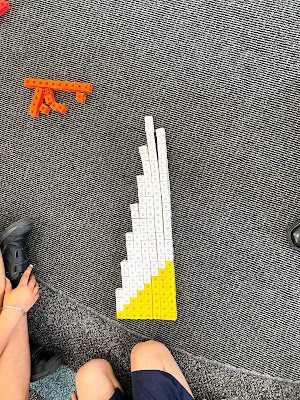We had been doing an investigation into Vitruvian Man this week. You know, the picture that Leonardo drew:
A fascinating picture with a fascinating story.
Anyway, all the scribble around the outside of the picture is actually Leonardo's mathematical calculations based on the ratios of the human body.
Did you know that, in the "ideal" human body:
- a palm is four fingers
- a foot is four palms
- a cubit is six palms
- four cubits is the height of a man
- a pace is four cubits
- a man is 24 palms tall
- the length of the outspread arms is equal to the height of a
man.
- from the hairline to the bottom of the chin is one-tenth of
the height of a man.
- from below the chin to the top of the head is one-eighth of
the height of a man.
- the maximum width of the shoulders is a quarter of the
height of a man.
- the distance from the elbow to the tip of the hand is a
quarter of the height of a man.
- the distance from the elbow to the armpit is one-eighth of
the height of a man.
- the length of the hand is one-tenth of the height of a man.
- the foot is one-seventh of the height of a man.
- from below the foot to below the knee is a quarter of the
height of a man.
- the distance from below the chin to the nose is equal to:
- The distance from the nose to the eye brows
- The distance from the eyebrows to the hairline
- The length of the ear
- One third of the face
Well, didn't we have a lot of fun exploring all these ratios and proportions!
So the next day, I took it in another direction. We hadn't played with blocks much this year, so I got some out and asked a few provocative questions:
- Get one block
- Get two blocks of a different colour
- Get two blocks of the first colour
- Get four blocks of the second colour
Continue.
How much are you increasing by?
How many blocks of colour #2 do you need if you start with 6 blocks of colour #1?
This was to look at what happens when you use ratios to increase a given value.
Here is what the kids did:
You can see what is happening here.
1 green + 2 yellows = 3 blocks
2 greens + 4 yellows = 6 blocks
3 greens + 6 yellows = 9 blocks
and so the pattern grows...
But if we look at the greens as being our 1x tables (1, 2, 3, 4...) and the yellows as being our 2x tables (2, 4, 6, 8...) then when we add them together we get the 3x tables! (3, 6, 9, 12...)
We tried this with 1x and 3x:
1 green + 3 yellows = 4 blocks
2 greens + 6 yellows = 8 blocks
3 greens + 9 yellows = 12 blocks
And it worked. (1x tables) + (3x tables) = 4x tables
"So what might be another way to work out your 4x tables?" I asked.
Quick as a flash, one bright young thing said, "2x tables plus 2x tables."
And he was right.
The Distributive Law in action.







No comments:
Post a Comment
Any comments you would like to make?